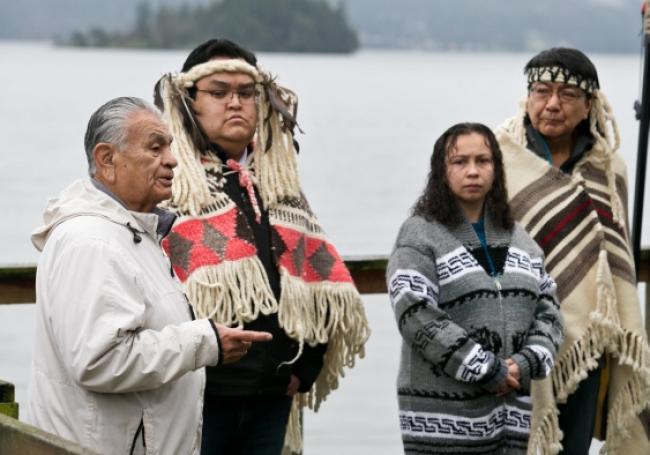Articles Menu

From left, Tom Sampson of the Tsartlip Nation speaks at a news conference with Tsartlip Chief Don Tom, Pauquachin Chief Rebecca David and Tsawout Chief Harvey Underwood, who vowed to fight an LNG plan by the neighbouring Malahat First Nation. Photograph By DARREN STONE
The Saanich Peninsula First Nations are promising a battle on the land, the sea and in the courtroom if Steelhead LNG plans to go ahead with a liquefied natural gas plant on the former Bamberton development lands.
Standing on Tsartlip First Nation land looking across Saanich Inlet at the site of the former cement factory where Steelhead envisions its project, the chiefs of the Saanich Peninsula nations — Tsartlip, Tsawout, Tseycum and Pauquachin, known collectively as WSANEC — made it clear they are united in opposition.
“We wanted to make a strong impact statement to make sure our statement is heard ... we are making it well known that we oppose LNG in our territory,” said Chief Rebecca David of the Pauquachin First Nation. “The decisions and choices we make today affect the next seven generations. We are trying to protect the water and the lands of our future children.”
David said opposition to the project seems to have fallen on deaf ears at the Steelhead offices.
But now that the Saanich Peninsula First Nations have come together to speak as one against the project, she hopes to get some traction.
“Hopefully, after today, they will be getting a clear statement that we are not going to allow this to come into our inlet,” David said. She added they are also united in their stance that there’s nothing Steelhead could offer to get them to support the project.
“There is no price you can put on the land and water ... we won’t be bought out at any time,” said David.
“They can keep raising the ante, but this land and water is not for sale and we are not about to jeopardize the future of our environment.”
Steelhead LNG, which has partnered with the Malahat First Nation for the project, is planning a floating facility capable of producing six million tonnes of LNG a year.
The facility, which is still in the design phase, is to be fuelled by a 128-kilometre natural gas pipeline. Most of the pipeline will run underwater and along the sea bed of the Saanich Inlet.
That’s a non-starter as far as Chief Don Tom of the Tsartlip First Nation is concerned.
Tom said the plant, the pipeline and shipping through the inlet threaten the environment and the First Nations’ way of life as they are a source of food, recreation and spiritual connectivity to the land and their ancestors.
“Our Douglas Treaty protects our right to live as we did formerly, to hunt and fish,” Tom said. He noted the fishing rights extend to anything that would infringe upon the nation’s ability to fish, gather prawns and use the water.
Tom said any government that approves such a project would trigger further protest action and likely a legal challenge.
“Douglas Treaty rights are not a myth and we are very good at winning court cases,” Tom said. “We are planning politically, legally — and determining what we can do on the ground and water.”
In a statement, the four Peninsula First Nations noted they are putting the province on notice that it cannot interfere in their treaty right. If the province provides permits and authorizes the project without the First Nations’ consent, it will be held liable.
Central Saanich Mayor Ryan Windsor said he fears seeing a repeat of the mistakes of the past by establishing a new industrial site at Bamberton.
“There is a very real risk of destroying this place,” he said.
In a joint statement emailed to the Times Colonist, the Malahat Nation and Steelhead said that like the WSANEC, they are committed to the health of the Saanich Inlet and its protection for future generations.
“It’s important to note the proposed Malahat LNG Project is a still at its earliest stages and that safety and environmental stewardship of the proposed project is our No. 1 priority,” they wrote.
The partnership added that it is committed to evaluating the project in a way that is respectful, transparent and science-based. “We are also fully committed to ongoing engagement with the WSANEC communities and other potentially affected First Nations, and will continue to reach out to meet with them to discuss any concerns they may have and work together to find ways to address them.”